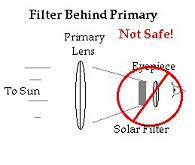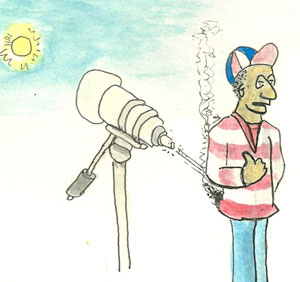 |
www.eclipse-chasers.com Solar Filters Author: Bill Kramer |
Eclipse Chaser
(noun) - Anyone that wants to see a total solar eclipse.  Search Eclipse Chasers Site
Search Eclipse Chasers Site |
Solar Filters
There is only one way to observe the sun with a telescope directly. That is with a solar filter. Not any filter will suffice for this sort of viewing. You must get the right filter for your telescope. The best place to start is by contacting the telescope manufacturer to see if they sell a solar filter for your particular telescope.
A solar filter deflects (or rejects) a significant amount of the energy from the Sun. There are two ways to accomplish this feat. The first involves a mirror like substance that reflects the light energy and only lets a small amount through. The second is a dark filter that absorbs the energy allowing only a small amount to get through for viewing. Solar observers generally prefer a reflection filter since they will not heat up as much as absorption filters.


The solar filter should be located at the front of the optics and not in between the main objective and the eyepiece. Older telescopes may come with a solar filter that attaches to an eyepiece - do not use these. There is a chance that the filter will crack due to the concentrated heat of the sunlight being focused by the primary lens/mirror to the eyepiece. If they happen to crack, they will no longer serve as an adequate solar filter and could result in eye damage if used.

Build your own solar filter: Check out these web sites for more information about building your own solar filter - Baader Planetarium and Mounting the Filter by Joe Cali. Joe Cali's write up about mounting is particularly important since he presents a solution optimized for eclipse chasers.
Solar Viewers: Viewers are cardboard glasses that allow for naked eye observation of the eclipsing sun. They should NOT be used for cameras, binoculars, and/or telescopes. The filter is typically a Mylar® sheet.
Do not look through a telescope or binoculars with these filters on. They are meant solely for direct observation of the sun without any additional optics. I strongly recommend NOT applying these filters with cameras!
There are two types of solar eclipse glasses on the market. One shows the sun in a blue color and the other provides a yellow-orange color. I recommend the yellow-orange style for most eclipse observers. The blue color filters appear silver in color while the yellow-orange color filters appear dark to the regular eye. The color produced by the filter is only visible when looking at the sun with the filters on. If you are computer processing your images then the color does not matter because you can make it what ever you desire.
Before using any filter always check it for holes or other flaws!
